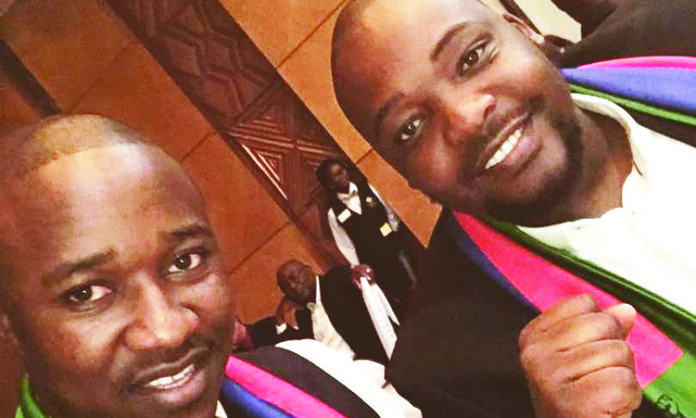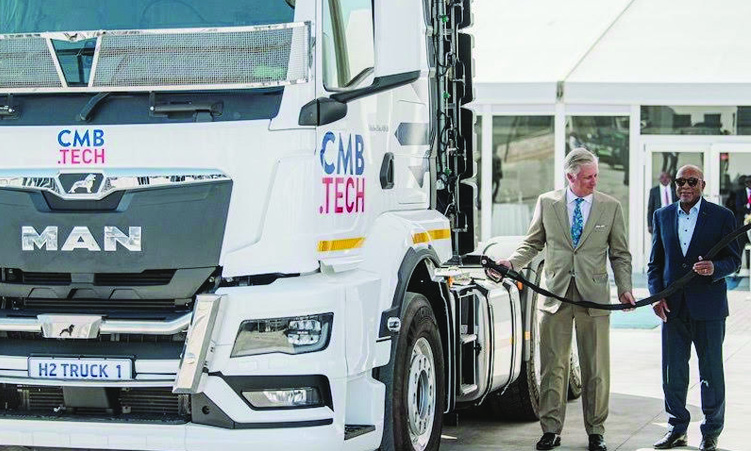15 July 2024
GREEN PARTNERSHIP … King Philippe of Belgium was in Namibia earlier this year for a state visit with president Nangolo Mbumba to advance the country’s green hydrogen ambitions and build an energy partnership against climate change.
By Timo Shihepo
Namibia has so far spent N$380 million on consultancy services, feasibility studies and subsistence and travel (S&T) allowances for the development of green hydrogen projects across the country.
These projects include Hyphen Hydrogen Energy, the Dâures green hydrogen village, Cleanergy Solutions, HyRail, Hydrogene De France (HDF), HyIron and Zhero.
It’s unclear which projects benefited from the funds, but Namibia Green Hydrogen Programme head of technical and construction Theopolina Kapani confirmed last month that “more than €20 million (N$380 million) has already been deployed”.
Namibia has received a total pledge of N$1,7 billion (€88 million) from European government-related companies.
Invest International from The Netherlands pledged the highest amount at N$835 million (€43 million).
Germany’s federal ministry of education and research pledged N$777 million (€40 million), its federal ministry for economic affairs and climate action pledged N$87 million (€4,5 million), and the European Union pledged N$23 million (€1,25 million).
Environmentalists and analysts have long criticised the government’s secrecy on green hydrogen projects.
Some are managed by politically connected and influential business people.

The Hyphen project, located in the Tsau //Khaeb National Park in the //Kharas region, is the most expensive green hydrogen project in Namibia, valued at approximately N$190 billion.
This project is run by the Hyphen Hydrogen Energy consortium, led by German company Enertrag, which has the rights to the project for 40 years.
Hyphen says this project would create at least 15 000 jobs, while Germany would receive green energy to replace fossil fuels.
The work has already begun in the desert inside a national park about 80 kilometres from Lüderitz.
About 500 wind turbines were imported from South Africa, and at least 40 square kilometres of solar systems are planned.
This project is estimated to cost about N$190 billion.
Hyphen chief executive Marco Raffinetti in January said the consortium’s investment in the project is confidential.
“It’s a double-digit millions of euros. It’s a lot.”
The Hyphen project is estimated to produce 300 000 tonnes of green hydrogen per year.
The H2-pilot plant/refuelling station at Walvis Bay is the second-most expensive green hydrogen project in Namibia, being developed for N$500 million.

The project is managed by Cleanergy Solutions Namibia, a joint venture between Ohlthaver & List (O&L) and Belgium-based CMB Tech.
O&L’s chairperson, Sven Thieme, says the grant support is less than half of the required investment, meaning shareholders put in significant funds to make the pilot plant a reality.
“Our early vision to become involved in a new uncharted industry and our willingness to invest into a non-commercial plant to unlock a future industry brought us to where we are today,” he says.
Innovations & Cleanergy Solutions Namibia group manager Eike Krafft says the grant funding will contribute about 40% of the investments required to realise the plant, meaning the consortium will have to fork out about N$300 million to finalise the project.
Construction commenced in August 2023, with the consortium expecting to produce the first hydrogen by mid-2024.
In May, Cleanergy Solutions Namibia imported 950kg of green hydrogen from Belgium for display at their Erongo region fuel station during Belgium’s King Philippe’s visit.
“We are confident that our phase one plant will unlock our hydrogen journey and be a foundation stone for a new industry in the region to come,” Krafft said.


DÂURES GREEN HYDROGEN VILLAGE
The Dâures Green Hydrogen consortium, which is developing the Daures Green Hydrogen Village, has been promised a N$220 million grant by the German government to implement the project in 18 months. The consortium consists of Enersense Namibia (90%), Dâure Daman Traditional Authority (7.5%), and Tsiseb Conservancy (2.5%).
Dâures Green Hydrogen consortium chief executive Jerome Namaseb last month said 90% (N$198 million) of the grant funds have been used so far.
“The greenhouse is on schedule and will be completed by the middle of July,” he said.
The project is located in the Erongo region, in the Dâures constituency.
The consortium says it will be producing a small quantity of green hydrogen, ammonia, and carbon-free agriculture this month.
This project involves consultant Panashe Daringo, described by industry insiders as one of the biggest beneficiaries of green hydrogen consultancy contracts in Namibia.
He insists that his relationship with green hydrogen commissioner James Mnyupe is “professional”.
Daringo said last year that his company, Mondjila Project Advisory and Management, provides the Dâures Green Hydrogen consortium with advisory and project management support, “as we do with all our 200 project sponsors, stakeholders and projects”.
At least N$150 million has been budgeted for the hydrogen-diesel dual fuel locomotive project proposal for Namibia with supporting research projects.
The project partners are CMB Tech together with the University of Namibia.
They are developing a 50-locomotive fleet conversion to green hydrogen dual fuel from Walvis Bay to the Kranzberg corridor in Namibia through TransNamib.
HyRail Namibia project coordinator Konrad Boshoff says the project is targeted for completion by 2025.
“If all goes according to plan, the locomotive will enter in-service operation on the Namibian railways.”
He says the project has the potential to revitalise Namibia’s rail logistics services by allowing investment in the rail industry.
University of Namibia spokesperson Simon Namesho says the university’s role is to support the project with scientific research in collaboration with the Federal Institute of Materials Research and Testing University from Germany.
SHIPS
The Green Hydrogen Applications in the Port Environment project at the Walvis Bay port, is estimated to cost N$110 million.
It is for a 5MW electrolyser and H2 mobile refueller, developed by Cleanergy Solutions Namibia consortium, which includes CMB Germany GmbH & Co. KG, the Namibia Ports Authority, and the University of Namibia.
Namport chief executive Andrew Kanime says his organisation is not directly involved at this stage.
Other projects include the Hydrogene De France at Swakopmund and the Oshivela project.






